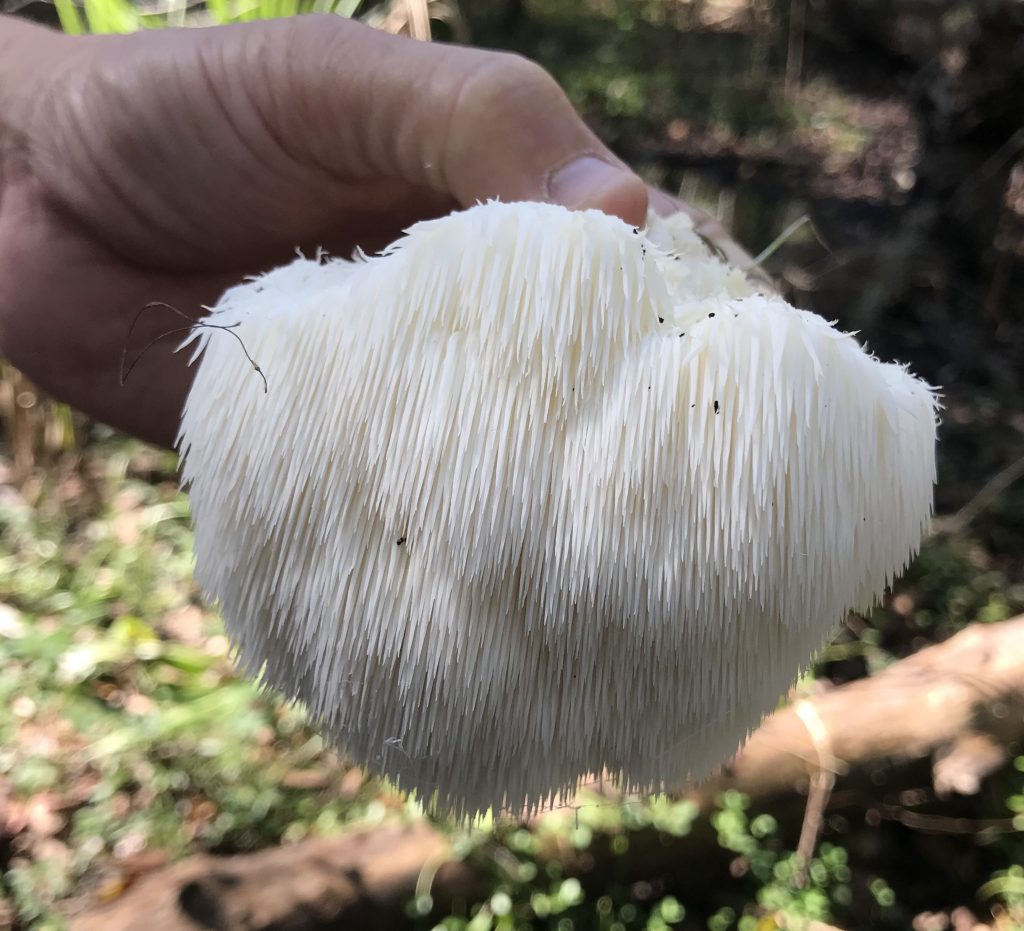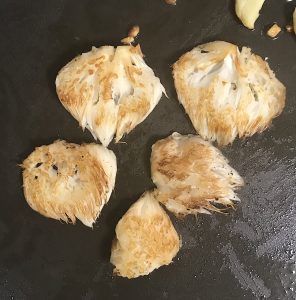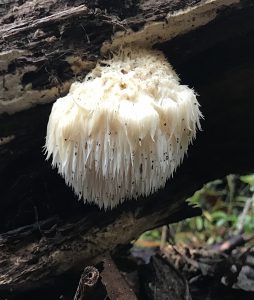
Lion’s Mane is tasty and medicinal. Photo by Green Deane
I see Lion’s Mane (Hericium erinaceus) on the same oak log every fall at the same time to the day. This is joyous and sad. I like finding it because I think they taste great. But it is also sad in that it and other fungi will do their job and reduce the log to powder and be gone. I have watched that happen to several trees with oyster mushrooms. Everything in life is temporary.

Sautéed in butter. Photo by Green Deane
I find this mushroom so tasty that I am not thinking about its nutrient content or it’s well-researched affects on brain function. Nutritional reports on Lion’s Mane differ greatly. This could be because wild and raised mushrooms vary. The raised ones tend to be higher in potassium than wild ones but lower in protein than wild ones. In general terms Lion’s Mane is about 43% protein, 61% carbs, 8% both fiber and fat. It has eight non-essential amino acids and seven essential amino acids adding up to some 14% of the mushroom’s dry weight. One hundred grams of Lion’s Mane has 65 grams of carbohydrates, 31 grams of protein, four grams of fat, and 35 calories. Ergosterol content is 381 mg, magnesium 123 mg, D2 (calciferol) 240 IUs, iron 20.3 mg, B3 (niacin) 18.3 mg, B1 (thiamin) 5.33 mg, potassium 4.46 mg, riboflavin 3.91 mg, calcium, sodium and phosphorus 1.2 mg each and folic acid 5.5 mcg. While there isn’t much sugar in Lion’s Mane two-thirds of it is glucose and ten percent mannose. Ergosterol has a similar function in mushrooms cells as cholesterol has in mammalian cells which is to maintain cell integrity (keep it from falling apart.) It’s a pre-cursor to vitamin D2. Ultraviolet light changes Ergosterol to D2. This is how mushrooms get vitamin D. As for the brain…

Same Fungi, same log, a year apart almost to the day. Photo by Green Deane
Research says Lion’s Mane might protect against dementia by stimulating brain cell growth. It’s also anti-inflammatory and can reduce mild symptoms of anxiety and depression. Lion’s Mane may help damaged nerves recover and protects against ulcers. The fungi can have positive cardio-vascular effects and help to manage diabetes. Lastly Lion’s Mane might have some anti-cancer properties. Personally I just really like the taste and texture of it. I grew up on the coast of Maine and it does taste like carb or lobster to me.
Hericium erinaceus (Hair-REE-cee-um air-wren-NAY-see-us) means “pertaining to hedgehog” and “like a hedgehog.” That said it might also come from Hircus which mean goat. It is more like a goat’s beard than a lion’s mane.
Green Deane “Itemized” Plant Profile
IDENTIFICATION: A white fungus though sometimes tinged with yellow or pink. It has soft teeth hanging from a center stalk (other species are branching.) The teeth can reach close to an inch long. It makes a white spore print.
TIME OF YEAR: They are a cool weather mushroom but that can vary greatly. You can find them in northern climes on 40 degree days or in north Florida were the nights are just eeking into the 50s.
ENVIRONMENT: They grow on hardwood, oaks, maple and beech. I usually find them on downed white oaks. They can be predatory on certain species of tree or ill trees. It decomposes dead wood.
METHOD OF PREPARATION: Many. I just sauté them in real butter.


I recently discovered a beautiful Lion’s Mane while serving as a resident volunteer at a Florida State Park. It sparked a new passion for mycology, especially edible varieties that I can begin to forage and reap the incredible benefits they offer. Since the day I stumbled across that glorious white friend, I have foraged and tried Turkey Tail (made tea), Indigo Milkcap, Pearl Oyster and Leather back lactarius. I’m so excited to learn as much as I can and I’ve chosen your website as one of my resources. I see you offer classes as well, so I’ll be perusing your schedule.